For many first-time Yellowstone National Park visitors, the chance to see a wild wolf, black bear or grizzly is at the top of the wish list. But information on how to see one of the large predators can seem contradictory.
Some wildlife web sites lead one to believe that seeing a bear or wolf is so easy that you don’t even have to really try. Then a newbie visitor arrives at a park bigger than some states, feels overwhelmed … and doesn’t see a bear.
On the flip side, many general travel forums lead one to believe that finding a bear or a wolf is not a realistic goal. I’ve seen countless commenters on Lonely Planet and Tripadvisor suggest that you won’t see a predator unless you spend several weeks backpacking, and even then you’d have to be extraordinarily lucky.
The truth is this: You can see bears and wolves in Yellowstone. You just need to know where and how to look.
I won’t guarantee you a sighting. But if you follow these tips, you should find bears, or wolves, or both. Have your own tips? Leave them in the comments.
-
Head North.
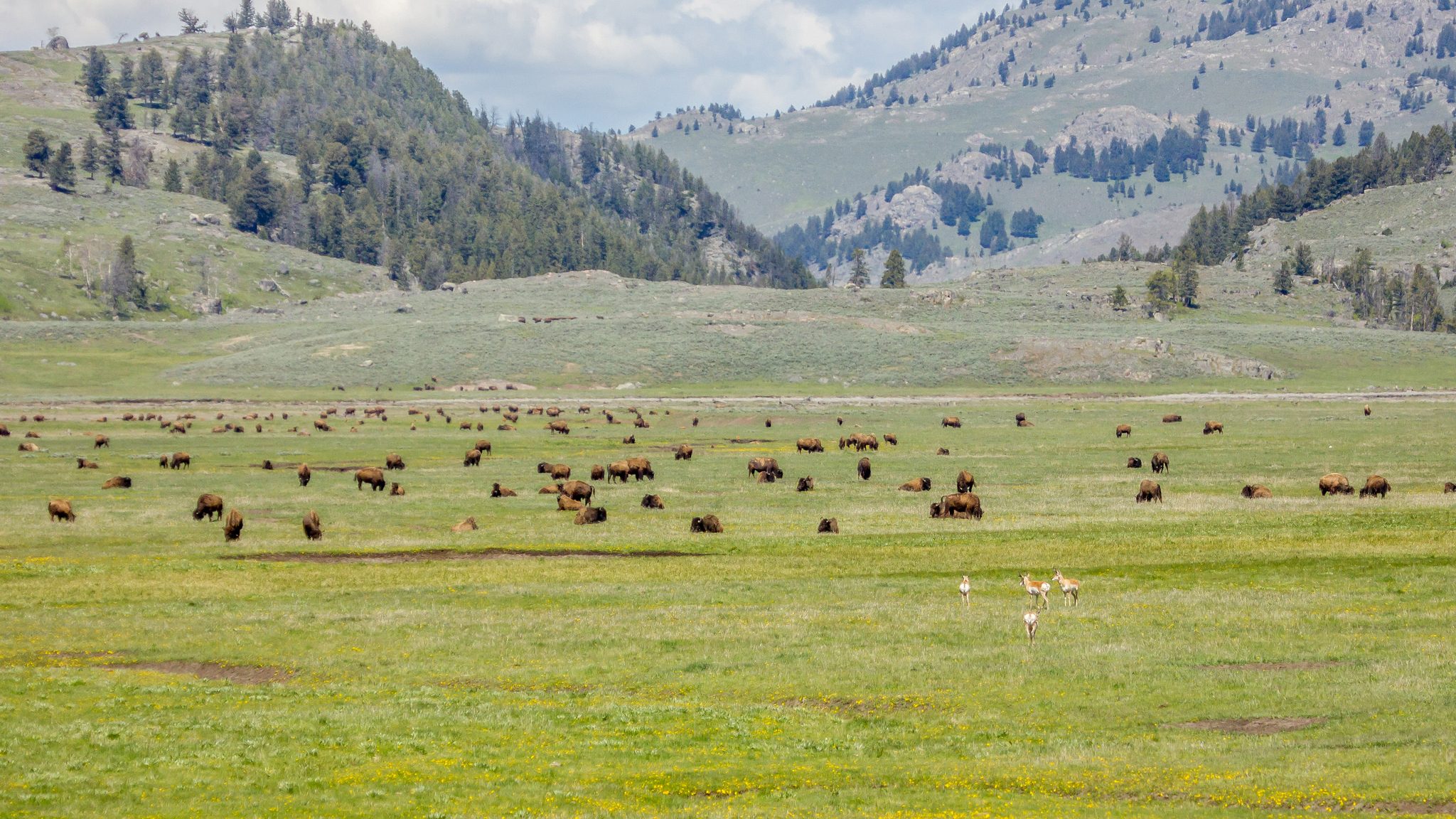
Bison and pronghorn in the Lamar Valley. Photo by Diane Renkin / Yellowstone National Park on Flickr in the Public Domain A visitor sees zero bears, and then pronounces bears “impossible to find.” The fact is that you are extremely unlikely to see a large predator at Old Faithful. If you want to see the best wildlife, head north to the comparatively less-visited part of the park.
The Lamar Valley has been called the Yellowstone’s “Serengeti” due to the open meadows and large herds of bison, pronghorns and other wildlife. Where there is prey, there are predators. Spend a lot of time looking in the Lamar Valley, and your chances at a great wolf or grizzly sighting increase exponentially.
The whole drive from Mammoth to the northeast exit at Cooke City, Montana, is great predator country. Black bears are commonly seen in the Tower area and meadows around Mammoth. Grizzly bears can often be spotted in these meadows as well.
The Hayden Valley is the one easily accessible spot in the southern part of the park that is worth a predator stake-out. Like Lamar, this is an open valley with lots of bison. Spend time at dawn or dusk, and you have a good chance at seeing wolves and grizzlies, sometimes at the same time.
-
Always be Alert, Even Away From the “Hotspots.”
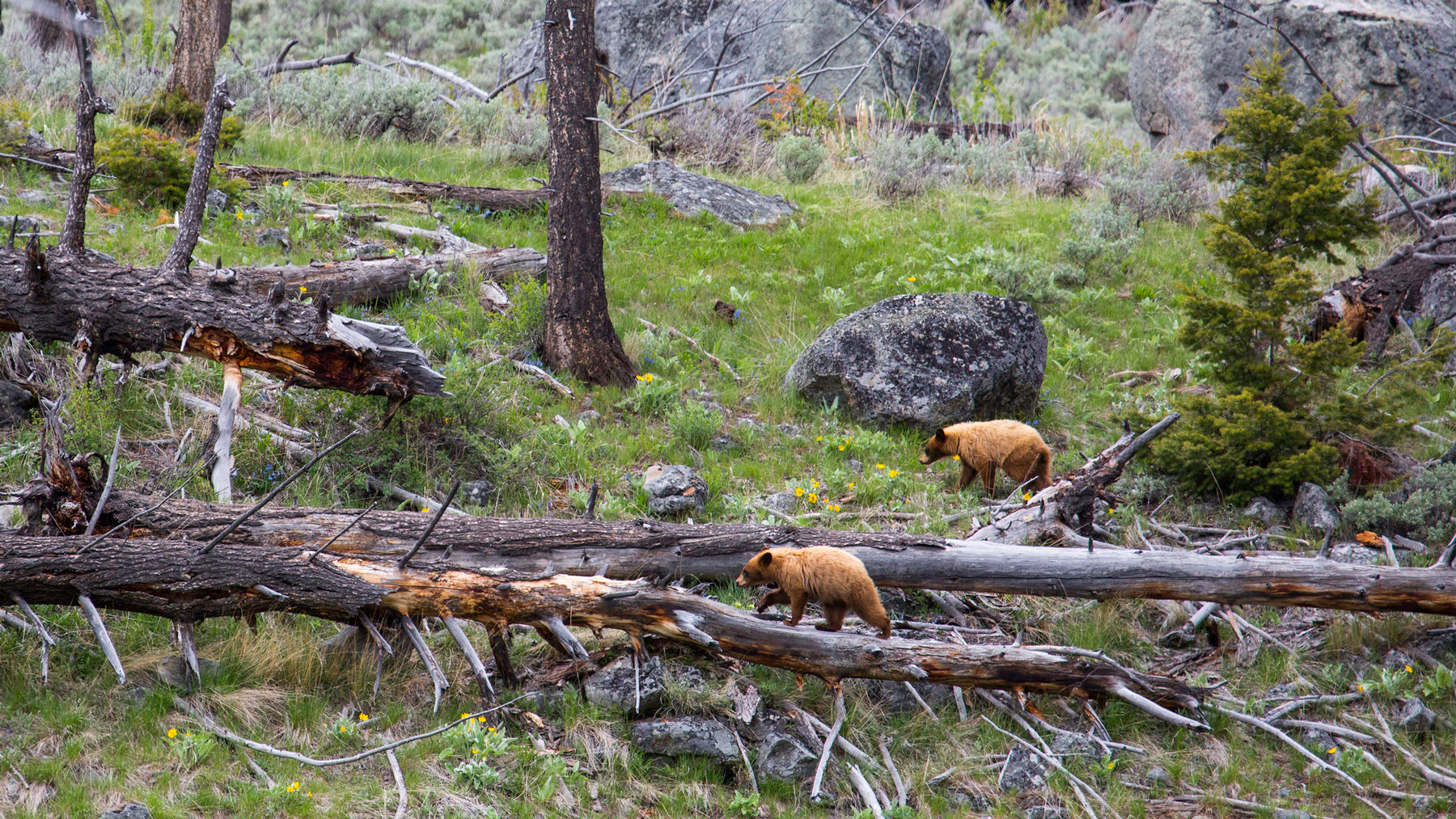
Yearling black bears (cinnamon), Slough Creek. Photo by Neal Herbert / Yellowstone National Park on Flickr in the Public Domain I watched the large wolf chewing on an elk leg, just a short distance off the road. Meanwhile, cars whizzed past – probably heading to Lamar Valley to look for wolves. We were in a part of the park not especially known for wolf sightings, and no active packs were reported in the area. But wolves roam.
It is true that some areas of the park are more reliable than others for wildlife. Yellowstone is also not a zoo. I think many great sightings are missed simply because visitors are not looking.
My best wolf sighting occurred at 10 pm driving (slowly) back to our lodging. A pack of wolves stepped onto the road, full moon in background, and walked around the car – just feet away. My best grizzly sighting? That would be on a national forest road just outside Grand Teton National Park. We were looking for moose when a very large bruin stepped across the gravel road, and then began rooting for ground squirrels. No other cars were in sight. Put in the time, get off the beaten path, and you’ll be amazed what you find.
-
Ask the Experts
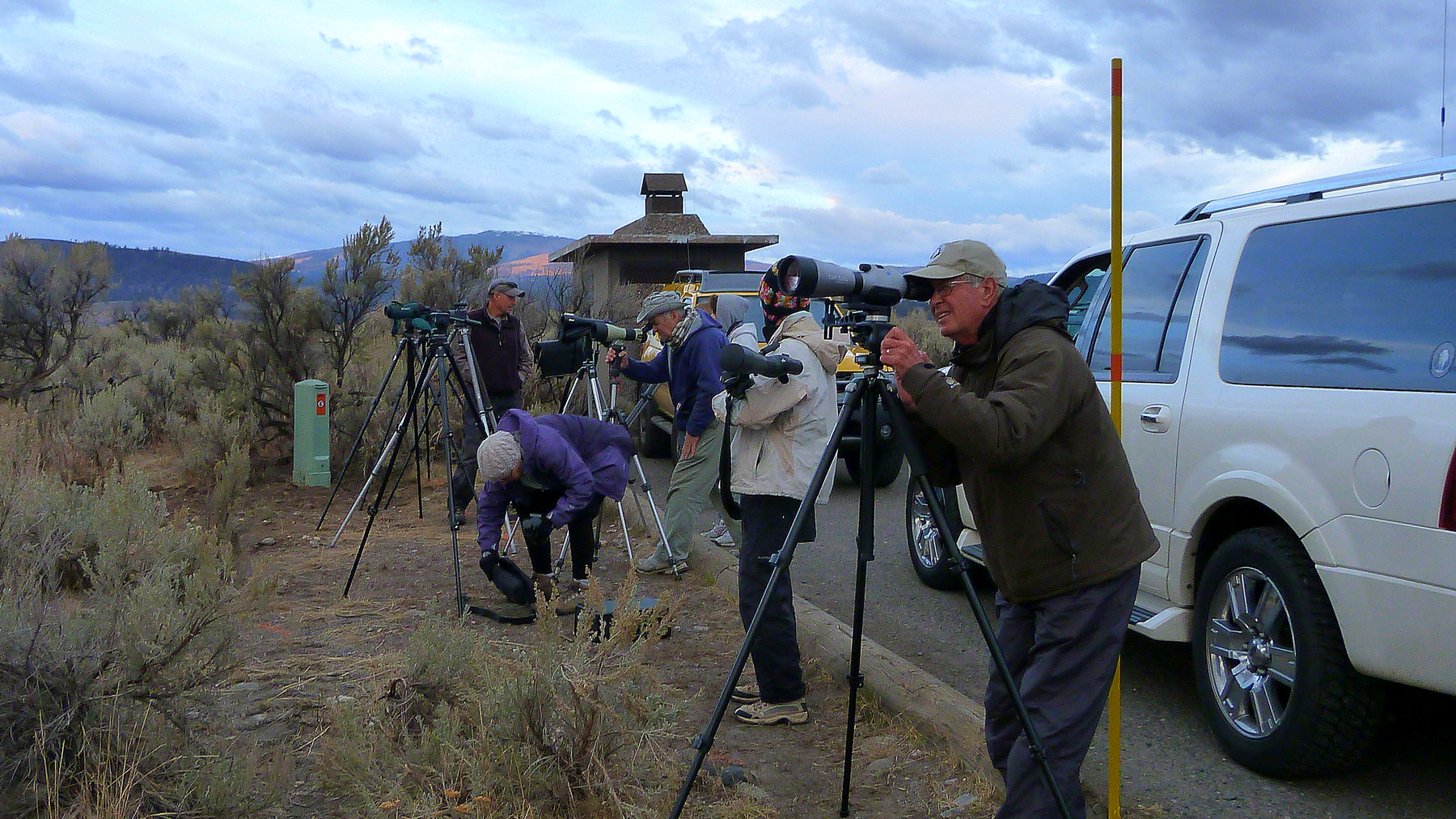
Wolf watchers in the Lamar Valley. Photo © F Delventhal / Flickr through a Creative Commons license Yellowstone’s wolves have attracted a network of super-fans, akin to a rock band’s followers who never miss a concert. You will see these folks in the Lamar Valley with large spotting scopes and intense gazes. They are usually quite friendly and will offer advice. Some know that a particular wolf has been emerging at a certain spot every evening. Some will let you peer through their scope at a distant wolf.
This next bit should go without saying, but I’ve seen it happen too many times. Don’t hop out of the car, music blaring, and yell “What are you looking at?!?!” This will not help you see wolves. Be courteous and polite, and experienced wildlife watchers will often help you find the critters.
You can also check on dedicated forums, like the excellent Yellowstone Net, for current hotspots and the latest news from wildlife watchers. These forums often list where wolves or grizzlies are being spotted, and can also point you to other interesting sightings like great gray owls, badgers, bighorn sheep and more.
-
Know How to Look
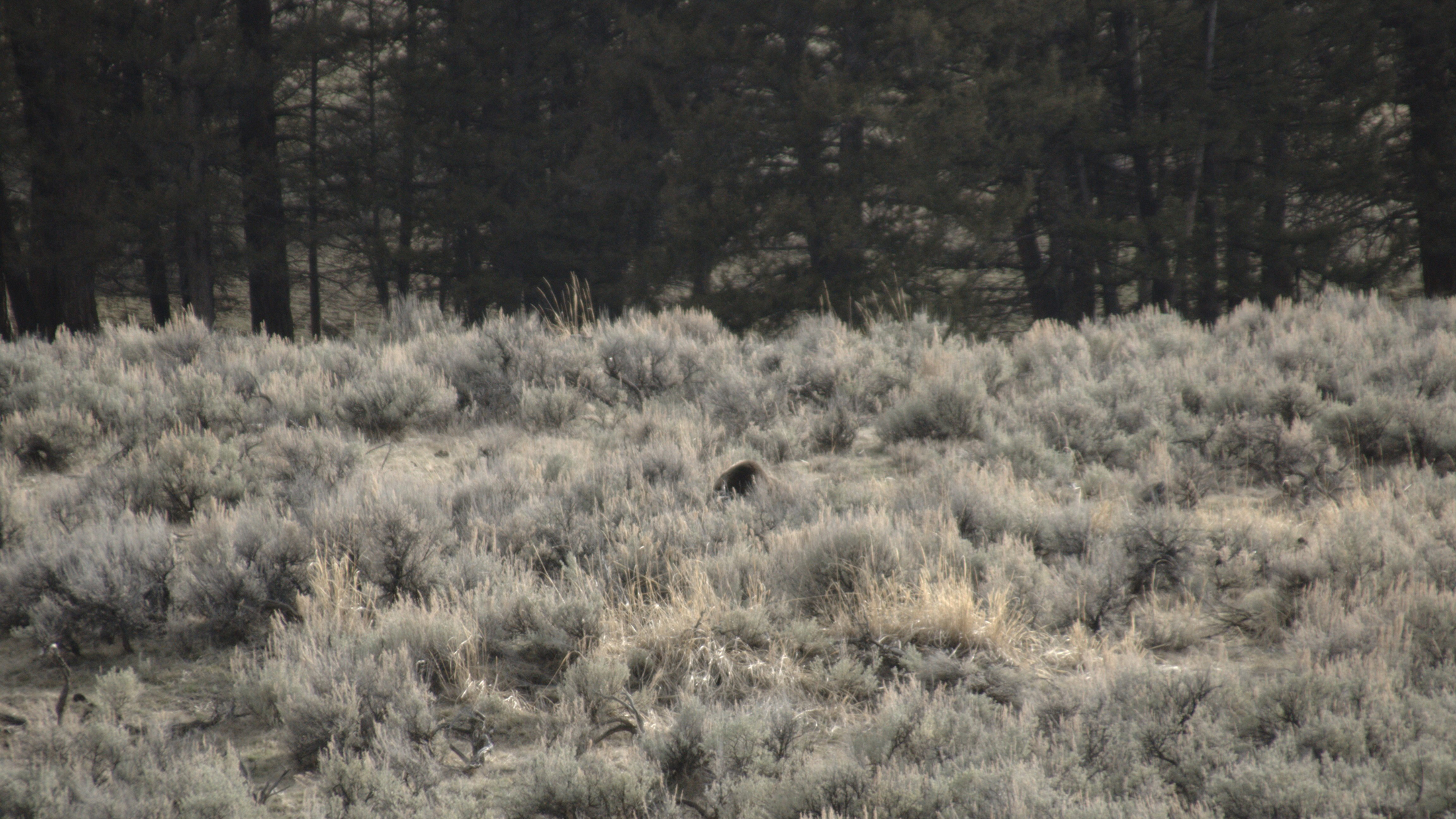
Yellowstone grizzly bear. Photo © Patrick Finnegan / Flickr through a Creative Commons license I’ve been looking for wildlife my whole life, so it can be easy to forget that there is an art to looking. I have had a bear step out of a meadow 50 yards away, but most sightings are not like that. You need to know how to look – seeking that bit of movement in the landscape, a patch of hair, something that just looks a bit more alive.
You will find yourself staring at a lot of stumps. But sometimes those stumps start to move and turn into a nice black bear.
The art of looking can be hard to explain. It mainly takes practice. Try finding birds at your neighborhood park. See how many wildlife species you can spot on an evening walk. Your eyes will be trained to look for wildlife, and you’ll see more.
Binoculars are a must — you can see a long way in the Lamar Valley. Many dedicated wildlife watchers use spotting scopes, too, but I have found that binoculars are sufficient most of the time.
Finally, be sure to study the differences between black bears and grizzly bears, and wolves and coyotes. There are many online guides that can help.
-
Carcasses!
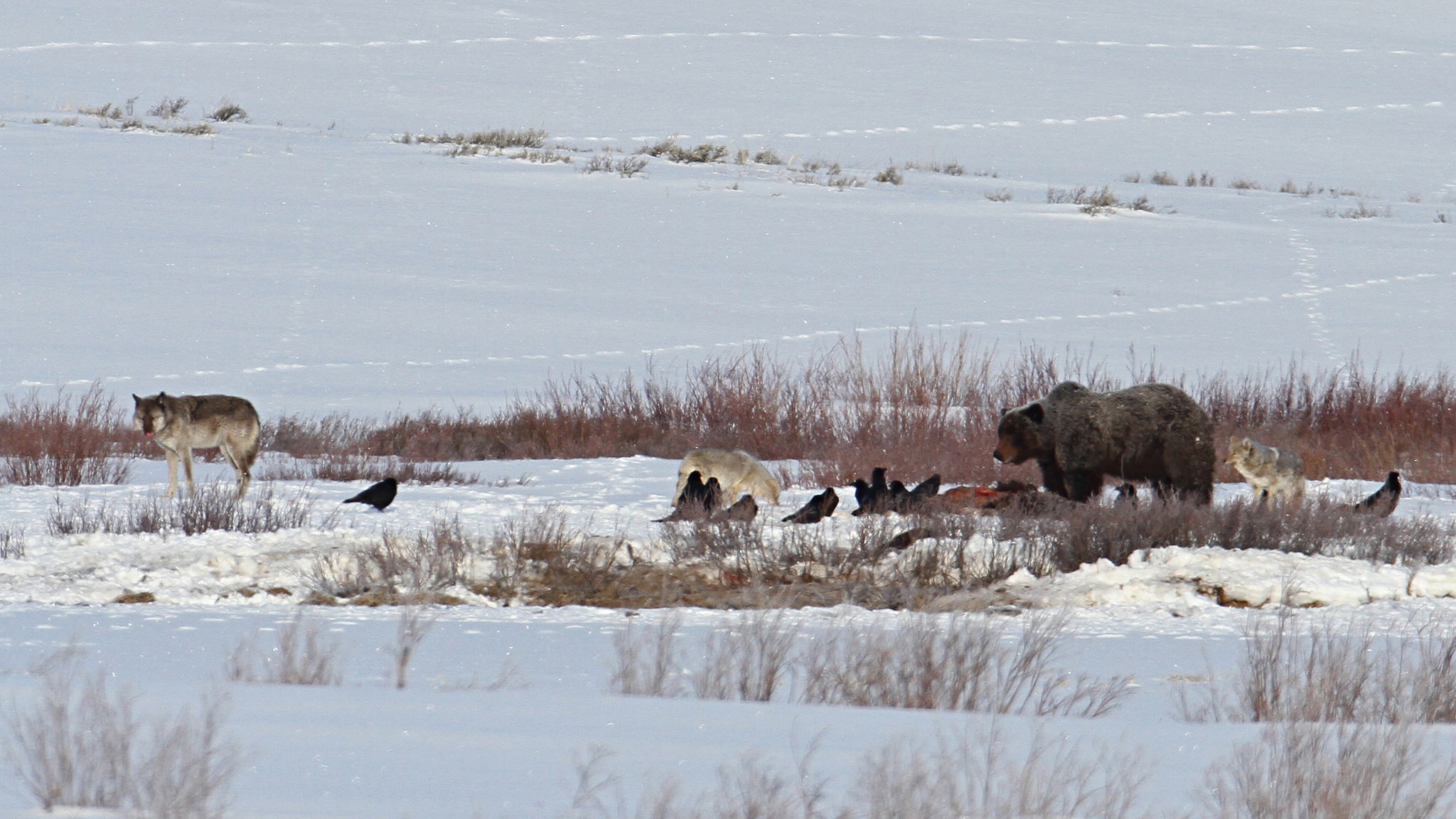
Grizzly, wolf, coyotes, ravens on carcass. Photo by Jim Peaco / Yellowstone National Park on Flickr in the Public Domain A dead elk or bison is a predator buffet. Stake it out, and you are going to see cool stuff. In fact, many of the people with spotting scopes you see in Lamar Valley are watching over a carcass. No predator passes up easy meat. Wolves, bears, coyotes, foxes, bald eagles, ravens and magpies all want the calories. This can lead to a lot of drama at kill sites. Sometimes the strong prevail, but the fast and nimble (like ravens) can often score some choice bits.
The disclaimer here is that should you find a carcass, you should be far away and in a vehicle. If you are hiking and come across a carcass, move away. Fast.
-
Visit During the Off Season
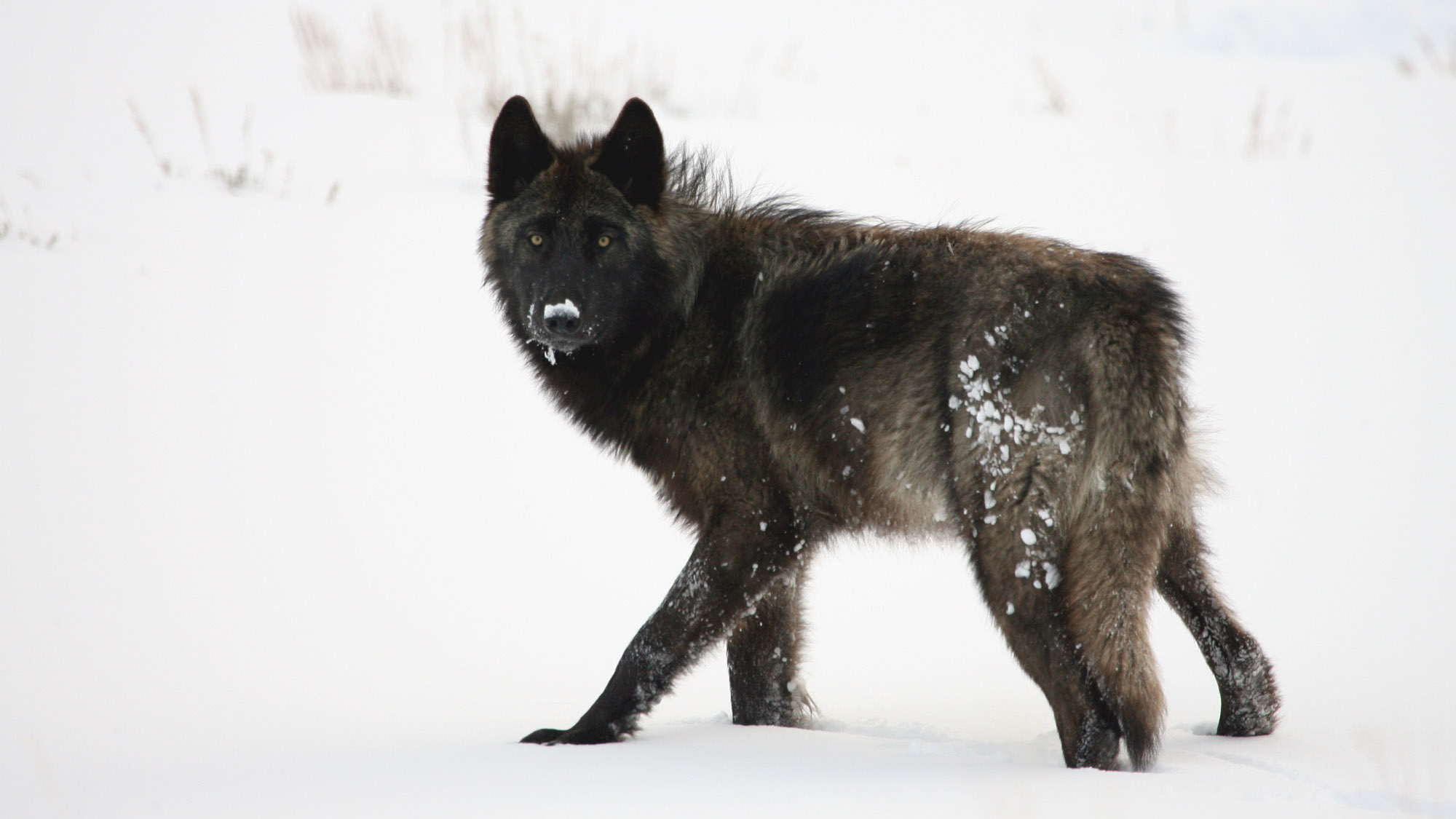
Wolf in Lamar Valley. Photo by Jim Peaco / Yellowstone National Park in the Public Domain I have had great predator viewing even during the busiest times in the park, like the July 4 holiday. But the off season can be rewarding too, and you’ll be sharing your sightings with a lot fewer visitors.
Grizzly bears emerge from hibernation in the spring and are actively seeking out food. Similarly, in the fall, they’re putting on weight for the winter. As a bonus, the elk are bugling.
In the winter, many enthusiasts enjoy watching wolves in the Lamar Valley (the northern road is the only one maintained in snowy conditions). Even in the southern part of the park, you can enjoy bison sightings (and even Old Faithful) with no one else around.
-
Don’t Overlook The Other Creatures
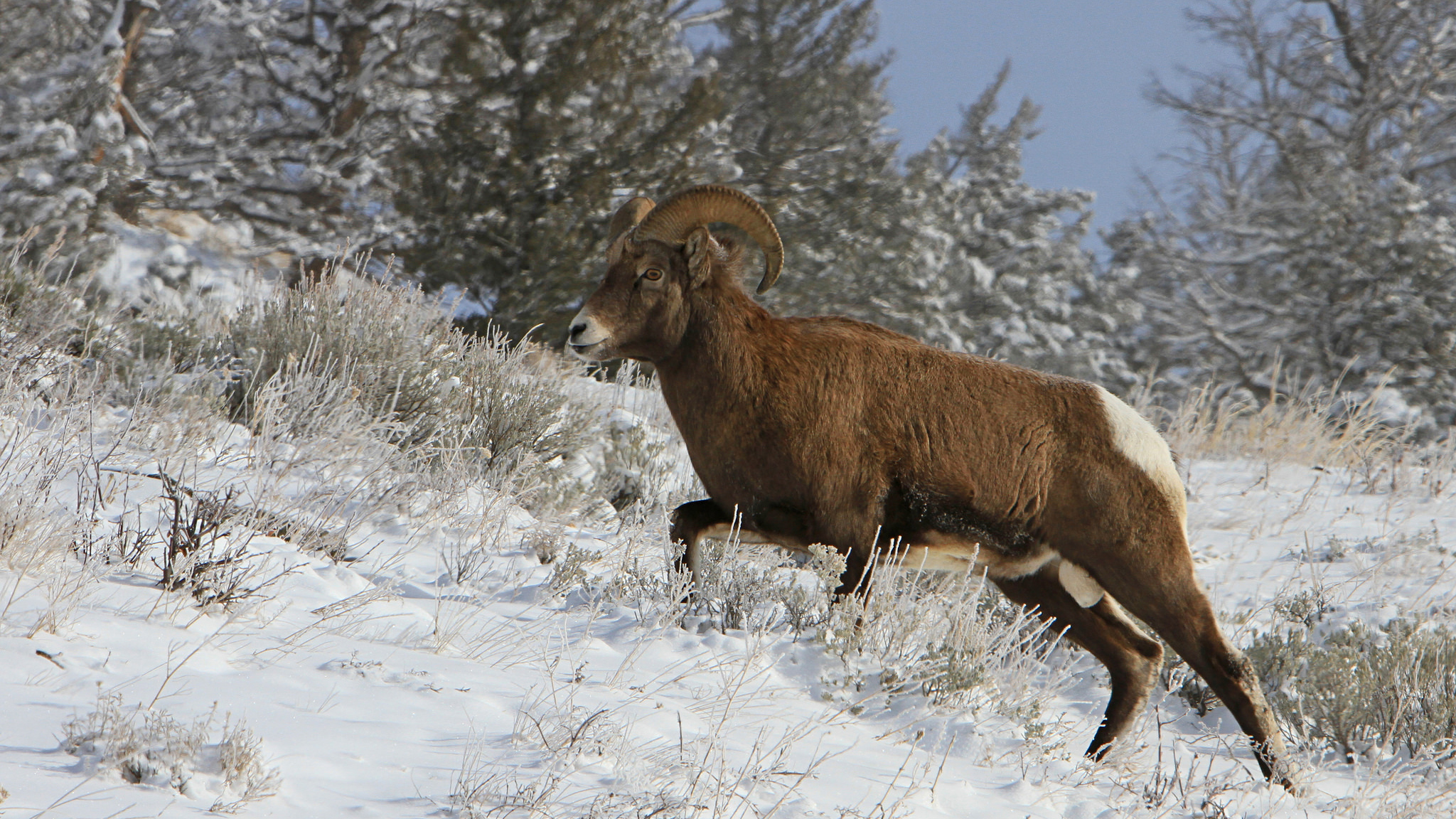
Bighorn sheep ram. Photo by Jim Peaco / Yellowstone National Park on Flickr in the Public Domain Yes, bears and wolves are awesome. But don’t lose sight of where you are, and the many other wildlife wonders around you. Bison are extremely abundant, but many seem to snap a few photos and then move on. Observe them (from a distance, of course). You might see a nursing calf, battling bulls, a herd swimming across a river, or a cow on alert for predators.
Look for smaller creatures. I’ve seen river otters catching and tearing apart cutthroat trout, Clark’s nutcrackers raiding camp sites, a badger trotting through sagebrush, a bighorn ewe giving birth to a lamb on the side of a cliff.
Every visit, I see something new. I know that sounds like a cliché, but it’s true. The park rewards the patient and observant naturalist. Every time.
-
Read and Learn About These Creatures Before You Go
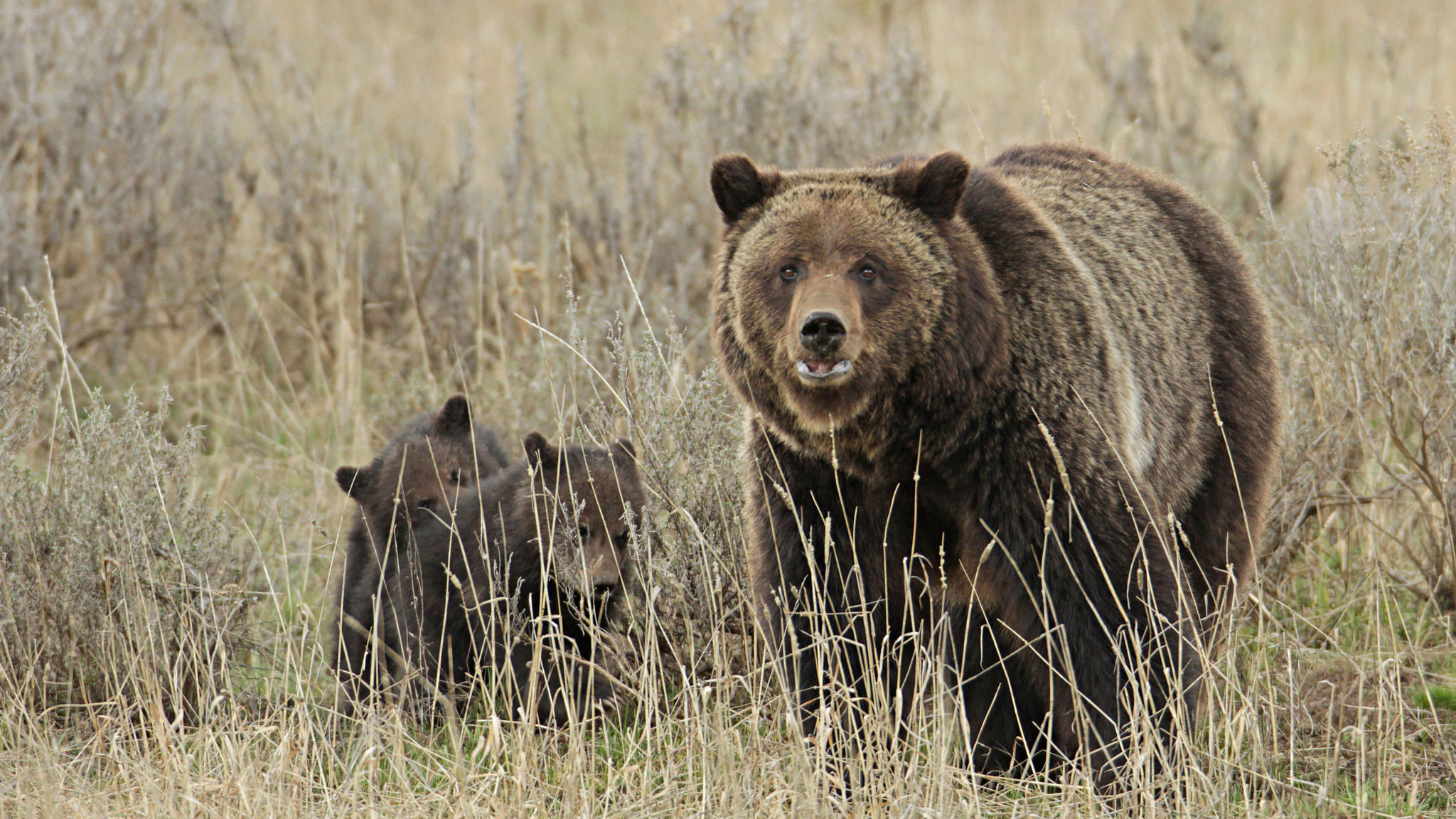
Grizzly sow and cubs near Fishing Bridge. Photo by Jim Peaco / Yellowstone National Park on Flickr in the Public Domain Understanding the creatures you’re seeking makes for a much more fulfilling adventure. Yellowstone’s wolves and bears are among the most-studied creatures on earth. This has led to an especially rich literature, both scientific and popular.
I particularly recommend Engineering Eden, a recent book by Jordan Fisher Smith. It tells the often tumultuous history of bears and people in the park, including the changing ideas on bear research and conservation. As difficult as it is to believe, at one point Old Faithful hosted a nightly bear feeding. This book is one of those that reads like a novel, and will add context to your grizzly sighting.
Cristina Eisenberg has researched how wolves have changed Yellowstone’s ecology, and has written a couple of excellent books on the topic. I particularly recommend The Wolf’s Tooth. Yellowstone historian Paul Schullery has written and edited many books on the park, including Yellowstone Bear Tales, filled with the humorous and horrifying ways people have interacted with the great beasts over the past century of the park’s existence.
There are many more. Reading these books won’t necessarily help you find the creatures of your quest, but they will give you an appreciation for their importance to the park’s ecology, and just how hard conservationists have had to work to keep (and restore) them.
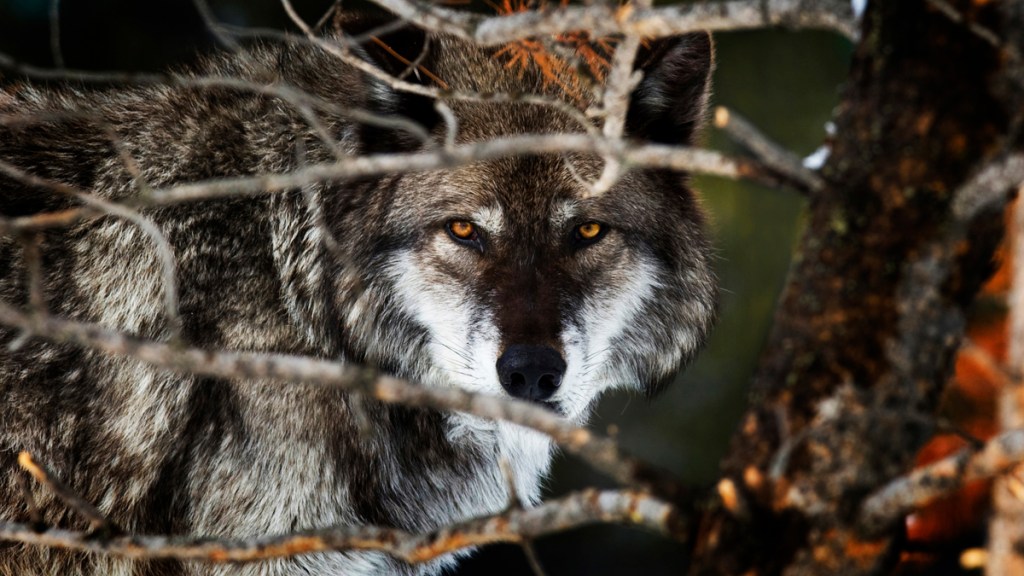



I think it’s ok to look for these animals, just not intensely, that means that staying on the roads and trails, respect them and let them do their thing, we can watch just not invade
In our case, in July 2014, encountering bears was purely accidental. We were on the trail (something like North Lookout Point, I would have to look up the name) directly adjacent to Old Faithful at 10 am. Joking “bears, bears!” and with bear spray on belt, off we went. Halfway up the short trail we heard some cracking in the brush and out tumbled two cubs. Our front person had the spray and stopped immediately, second in line was playing on her phone, and I in tow froze and started whispering “bears…bears!”…knowing Mama wasn’t far behind…when out she came. I was too scared to recall if we get big and scream or play dead…and was too petrified to do anything other than freeze, perhaps pass out and appear dead, and definitely knew better than to run and couldnt move my legs to anyway . The trio was only feet in front of us on the trail. Then Mama stood up on hind legs and Ithought here we go…she’s going to charge our guy w the spray but also a bad leg, and I’ll be too horrified to run. She sniffed at the air, apparently decided we weren’t a threat, and lumbered off w cubs following. We turned back singing the alphabet and happy birthday to the the trailhead…the immediately went to the Lodge’s bar. Lesson learned…be prepared and alert!
Was in Yellowstone and Grand Teton NPs last year in the fall it was amazing. We saw a lot of birds, and of course bison, pronghorn, elk and deer. We bought books on the variety of wildlife to know what to look for. It was the best trip ever, can’t wait to go back and see if we can ever catch a glimpse of Bear 399 and a wolf pack.
Thank you for the information. I have been to Yellowstone 6 times. I have seen most of the animals in the part. We are taking our youngest daughter and her husband on this trip. Yellowstone is my favorite place to visit. We live in WV. Our son-in-law is very excited to be going with us.
Great article. Every bit of what you stated I found to be true and what we experienced as first time visitors to the park. Thank you.